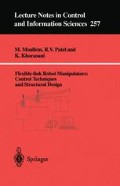Abstract
In this chapter, a control scheme was proposed for achieving greater accuracy for tip position tracking in structurally flexible robotic manipulators. Theoretical estimates show that the tracking errors converge to a residual set of O(ε2), and experimental results show that smaller tip position tracking errors are achieved compared to conventional algorithms in the literature. The only measurements required by the control law are joint positions, velocities and tip positions. This is an attractive feature from a practical implementation point of view as tip deflection rates are not directly measured, but tip positions can be readily measured by camera vision systems or strain gauge sensors. The control law is more complicated than its rigid counterpart; however the use of symbolic manipulation software and fast real-time control technology make the implementation of such a control law feasible.
Preview
Unable to display preview. Download preview PDF.
Rights and permissions
Copyright information
© 2000 Springer-Verlag London Limited
About this chapter
Cite this chapter
(2000). Tracking control by integral manifolds. In: Flexible-link robot manipulators. Lecture Notes in Control and Information Sciences, vol 257. Springer, London. https://doi.org/10.1007/BFb0110151
Download citation
DOI: https://doi.org/10.1007/BFb0110151
Published:
Publisher Name: Springer, London
Print ISBN: 978-1-85233-333-1
Online ISBN: 978-1-84628-555-4
eBook Packages: Springer Book Archive

